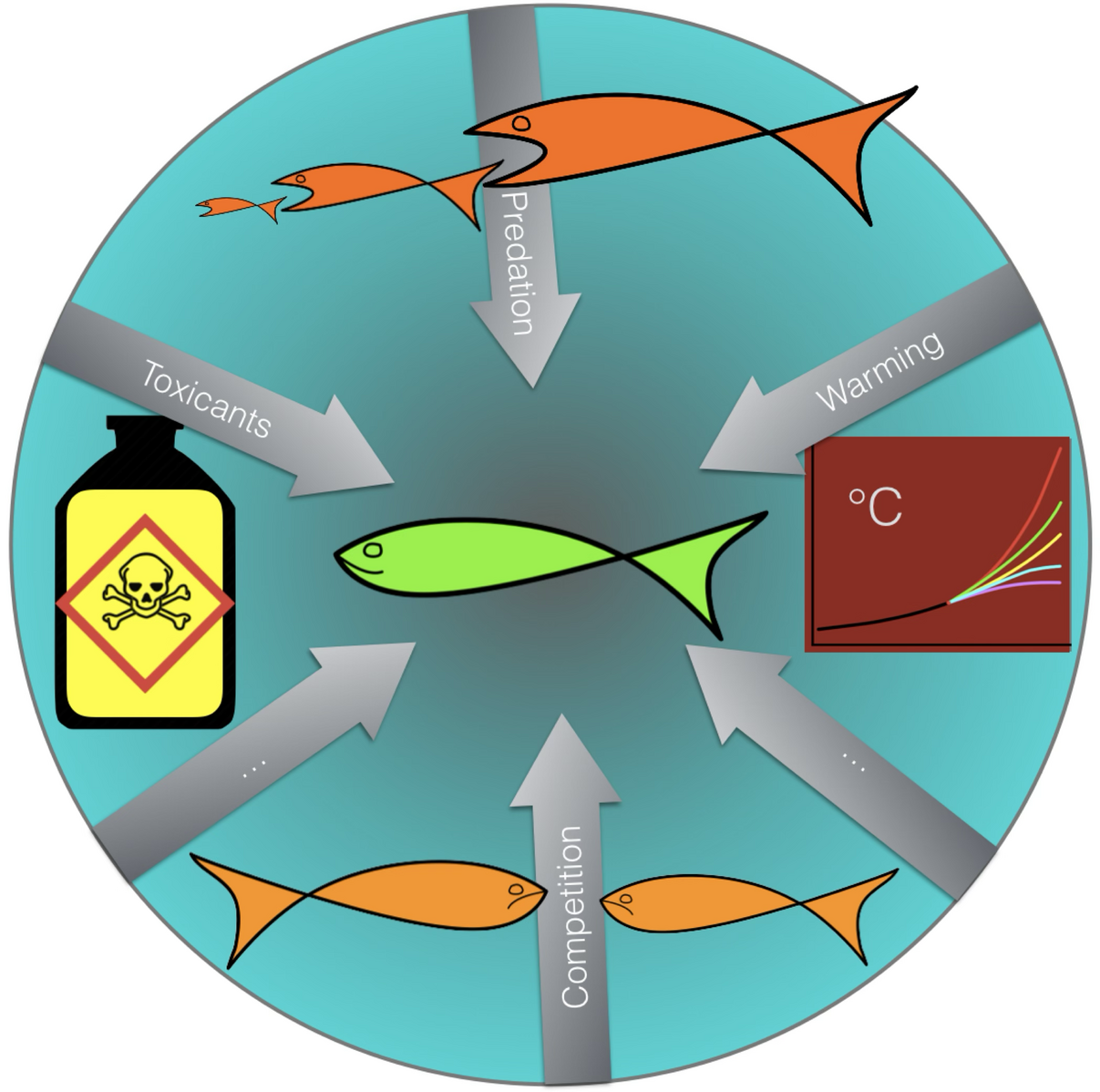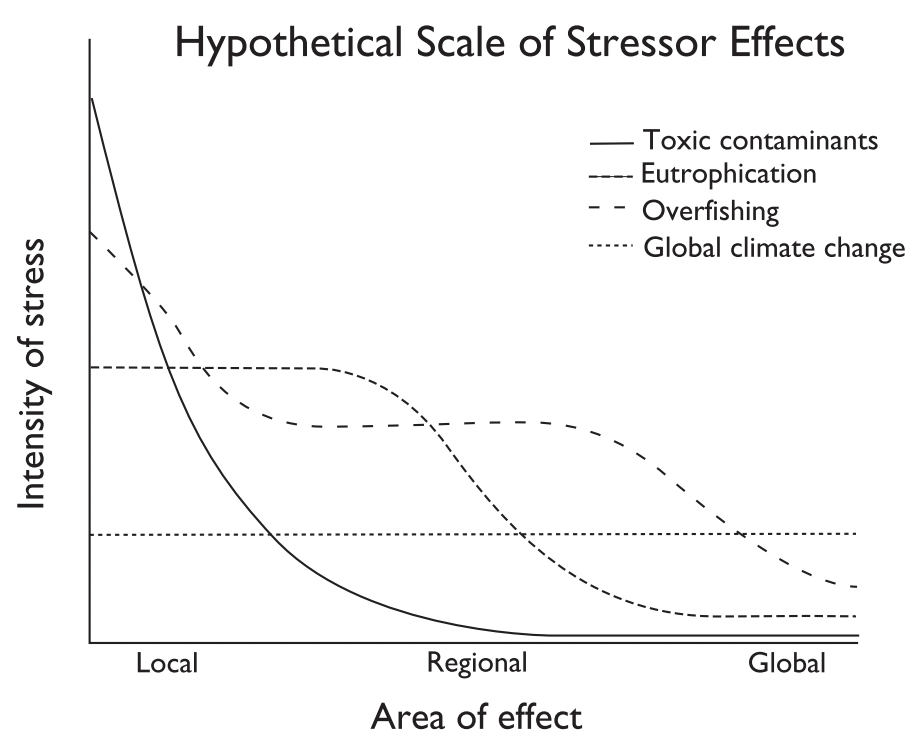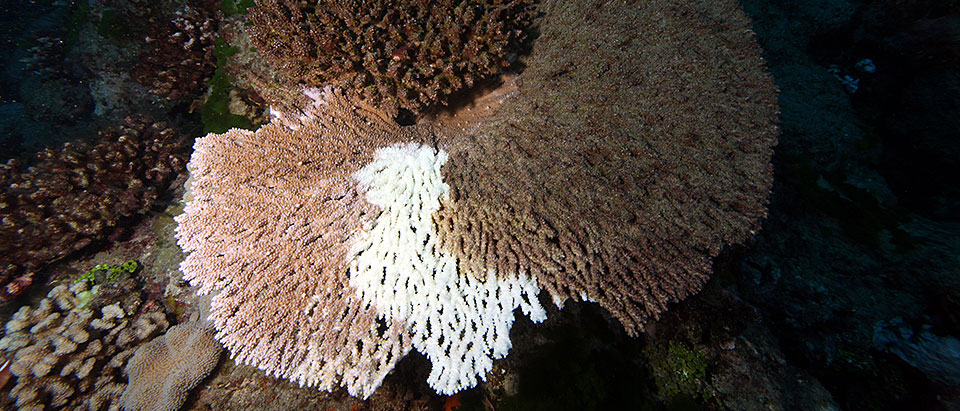IB Syllabus focus:
‘Most ecosystems face multiple, compounding human pressures; reduced resilience from one stressor (e.g., warming) amplifies impacts of others (e.g., invasives).’
Ecosystems rarely face a single challenge. Instead, they encounter multiple, overlapping pressures that interact in complex ways, weakening resilience and amplifying ecological damage across scales.
Understanding Multiple Impacts
Ecosystems are dynamic systems influenced by both natural variability and human activity. When multiple human pressures occur together, their combined effects can be more harmful than any single factor acting alone.

Conceptual diagram showing multiple environmental stressors—warming, toxicants, predation, and competition—converging on an organism at the same time, emphasising non-additive interactions and elevated risk. The clean, labelled arrows make the layering of pressures explicit and easy to interpret at IB level. Source.
Single stressors may reduce ecosystem health, but ecosystems can often recover.
Compounding stressors interact to create feedback loops, where the effect of one pressure intensifies the consequences of another.
Reduced resilience (the ability of an ecosystem to absorb disturbance and recover) increases vulnerability to collapse.
Resilience: The capacity of an ecosystem to resist disturbance and maintain essential functions and structure, while recovering after stress.
Types of Human Pressures
Climate Change
Rising temperatures shift species ranges and alter seasonal patterns.
Ocean warming and acidification reduce coral reef survival.
Extreme weather events damage habitats and stress populations.
Habitat Loss and Fragmentation
Deforestation, urbanisation, and agricultural expansion reduce available space for species.
Fragmented landscapes limit gene flow and make species more vulnerable to additional stressors like climate change.
Pollution
Industrial discharge, agricultural runoff, and plastics degrade ecosystems.
Pollutants accumulate in food webs, reducing species health and reproductive success.
Pollution weakens species, lowering their capacity to adapt to other pressures.
Overexploitation
Overfishing, poaching, and unsustainable hunting reduce populations below viable levels.
Reduced population size magnifies impacts of other stressors such as disease or invasive species.
Invasive Alien Species
Introduced species outcompete natives for food and habitat.
Invasives spread diseases and alter ecosystem functioning.
Their impacts intensify in systems already stressed by habitat change or warming.
Interactions Between Stressors
Synergistic Effects
When two or more stressors interact, the outcome is greater than the sum of their individual effects.
Examples:
Climate change + habitat loss: Species forced to shift ranges due to warming cannot adapt if corridors are blocked by agriculture or cities.

Line graph comparing stressors by intensity and area of effect—toxic contaminants (local, intense), eutrophication/overfishing (regional), and global climate change (broad, pervasive). The figure clarifies why overlapping drivers at different scales can compound ecological impacts and overwhelm resilience. Source.
Pollution + disease: Pollutants weaken immune systems, increasing susceptibility to pathogens.
Synergistic effect: An interaction where combined pressures produce impacts greater than the sum of their individual effects.
Amplification of Impacts
Warming oceans stress corals; bleaching reduces resilience, making reefs more susceptible to invasive crown-of-thorns starfish.

Photograph of a coral colony with a white, recently eaten section caused by a crown-of-thorns starfish, illustrating how a prior stressor (bleaching) can amplify the impact of a subsequent biotic stressor. This image underscores compounding effects central to multiple-stressor ecology. Source.
Deforestation not only reduces habitat but also intensifies climate change through increased carbon emissions, worsening regional droughts.
Cascading Consequences
Loss of a keystone species can destabilise entire food webs.
Reduced prey availability forces predators to shift diets, pressuring other species.
Ecosystem collapse in one area may spread impacts to neighbouring systems.
Ecosystem Resilience Under Multiple Pressures
Resilience depends on biodiversity at habitat, species, and genetic levels. Multiple pressures reduce this diversity, limiting adaptability.
Genetic erosion from small, fragmented populations lowers adaptive potential.
Species loss reduces functional diversity, weakening ecosystem services such as pollination or nutrient cycling.
Habitat degradation disrupts ecological interactions necessary for resilience.
Functional diversity: The range of different ecological roles performed by species within an ecosystem.
Case Examples of Multiple Pressures
Coral Reefs
Stressors: Ocean warming, acidification, pollution, and overfishing.
Interactions: Bleaching events reduce resilience; invasive algae spread more easily where herbivorous fish have been overharvested.
Outcome: Significant biodiversity loss and reduced fisheries productivity.
Tropical Forests
Stressors: Logging, agriculture, climate variability, and invasive plants.
Interactions: Fragmentation reduces genetic diversity; warming increases fire risk, which is amplified by dry conditions caused by land clearance.
Outcome: Reduced carbon storage and weakened ecosystem services.
Arctic Ecosystems
Stressors: Warming, habitat disruption from oil exploration, and invasive species migration.
Interactions: Ice loss reduces habitat for polar bears; pollutants transported long distances accumulate in top predators.
Outcome: Species face declining resilience under combined pressures.
Management Challenges
Managing ecosystems under multiple pressures requires acknowledging complexity:
Conservation strategies must address more than one driver at a time.
Adaptive management involves monitoring ecosystems and adjusting approaches as new stressors emerge.
Integrated policies recognise interactions between climate change, land use, pollution control, and invasive species management.
Bullet-point approaches:
Strengthen habitat connectivity to allow species movement.
Reduce pollution inputs to lessen compounding effects.
Protect large, diverse ecosystems to buffer against multiple stressors.
Incorporate climate change projections into conservation planning.
Human Dimensions
Human actions are both the drivers of pressures and the source of solutions.
Socioeconomic pressures such as demand for food, energy, and land create stressors.
Effective responses require international cooperation, indigenous knowledge, citizen science, and strong governance frameworks.
Environmental Justice
Vulnerable communities are disproportionately impacted by compounded pressures.
Conservation strategies must balance ecological protection with social equity.
Key Takeaways
Multiple, overlapping human pressures are the norm for ecosystems, not the exception. Reduced resilience from one stressor magnifies the damage of others, leading to cascading ecological impacts. Understanding these interactions is critical for designing effective conservation and management strategies.
FAQ
Scientists use controlled experiments, long-term monitoring, and computer models to observe how stressors interact. For example, field studies might compare areas exposed to both warming and pollution with areas exposed to only one stressor.
Modelling allows researchers to predict potential outcomes under different combinations of pressures. This is especially useful for planning conservation strategies where direct experimentation is not possible.
Individual stressors often have measurable, linear impacts. Synergistic effects, however, are non-linear and context dependent.
The same pair of stressors can produce different results in different ecosystems. For example, warming plus nutrient pollution might cause algal blooms in lakes but have different outcomes in marine systems.
The timing of stressors is critical. If they occur simultaneously, their impacts may compound immediately.
If stressors occur sequentially, the first may weaken resilience, increasing vulnerability to the second. For instance, deforestation followed by drought can lead to more severe soil degradation than either alone.
Reduced fish stocks from overfishing combined with pollution diminish food security.
Coral reef degradation from bleaching plus invasive species limits coastal protection and tourism.
Forest fragmentation combined with climate stress lowers carbon storage capacity.
Ecosystem services decline most rapidly when stressors act together, reducing human well-being.
Are some ecosystems more vulnerable to multiple stressors than others?
Yes, ecosystems with naturally low resilience or already degraded conditions are more at risk.
Coral reefs and Arctic systems are highly sensitive due to narrow tolerance ranges.
Fragmented habitats with reduced biodiversity cannot buffer impacts effectively.
Ecosystems with high connectivity, like river systems, spread impacts rapidly.
Practice Questions
Question 1 (2 marks)
Explain what is meant by a synergistic effect when multiple stressors act on an ecosystem.
Mark scheme:
1 mark for identifying that synergistic effects occur when the combined impact of stressors is greater than the sum of individual effects.
1 mark for providing an example, such as pollution weakening immune systems and thereby increasing disease susceptibility.
Question 2 (5 marks)
Discuss how reduced resilience from one stressor can amplify the impacts of others in an ecosystem. Use one named example to support your answer.
Mark scheme:
1 mark for defining resilience as the ability of an ecosystem to recover after disturbance.
1 mark for stating that when resilience is reduced by one stressor, the ecosystem becomes more vulnerable to additional stressors.
1–2 marks for explaining how interactions between stressors create compounding or cascading effects (e.g., bleaching making corals more susceptible to invasive crown-of-thorns starfish).
1 mark for a relevant named example that demonstrates the process clearly.
1 mark for linking the example back to the concept of reduced resilience and multiple interacting stressors.

